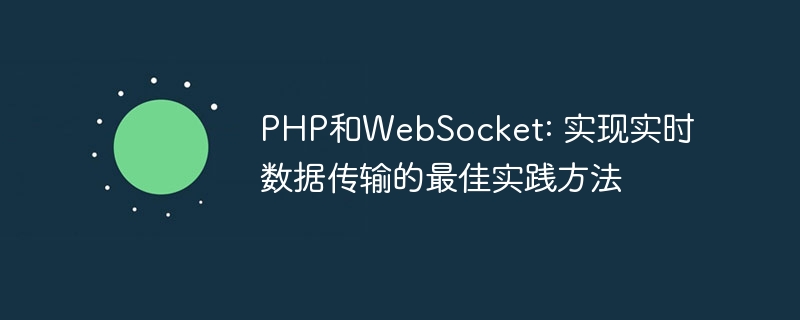Home >Backend Development >PHP Tutorial >PHP and WebSocket: Best practices for real-time data transfer
PHP and WebSocket: Best practices for real-time data transfer
- WBOYWBOYWBOYWBOYWBOYWBOYWBOYWBOYWBOYWBOYWBOYWBOYWBOriginal
- 2023-12-18 14:10:221661browse

PHP and WebSocket: Best practices for real-time data transmission
Introduction:
In web application development, real-time data transmission is a very important Important technical requirements. The traditional HTTP protocol is a request-response model protocol and cannot effectively achieve real-time data transmission. In order to meet the needs of real-time data transmission, the WebSocket protocol came into being.
WebSocket is a full-duplex communication protocol that provides a way to communicate full-duplex over a single TCP connection. Compared with the HTTP protocol, WebSocket can achieve faster data transmission and real-time data push. Due to its excellent performance and wide support, WebSocket is widely used in real-time applications.
To implement WebSocket communication in PHP, we can use some mature libraries to simplify the development process. This article will introduce how to use the Ratchet library to implement the integration of PHP and WebSocket, and provide some best practices so that you can easily build applications for real-time data transmission.
1. Configuration environment and installation dependencies
In order to use the Ratchet library, you need to meet the following environment and dependency conditions:
- PHP version >= 7.0;
- Composer tool.
The installation steps are as follows:
- Create a new project directory and enter the directory on the command line.
-
Use Composer to install the Ratchet library. Enter the following command at the command line:
composer require cboden/ratchet
This will automatically download and install the Ratchet library and its dependencies.
- After the installation is complete, you can start using Ratchet in your project.
2. Create a WebSocket server
You can easily create a WebSocket server using the Ratchet library. The following is a simple sample code:
use RatchetMessageComponentInterface;
use RatchetConnectionInterface;
require 'vendor/autoload.php';
class MyWebSocketServer implements MessageComponentInterface {
protected $clients;
public function __construct() {
$this->clients = new SplObjectStorage;
}
public function onOpen(ConnectionInterface $conn) {
$this->clients->attach($conn);
echo "[New connection] - Connection ID: {$conn->resourceId}
";
}
public function onMessage(ConnectionInterface $from, $msg) {
// 处理收到的消息
foreach ($this->clients as $client) {
if ($from !== $client) {
$client->send($msg);
}
}
}
public function onClose(ConnectionInterface $conn) {
$this->clients->detach($conn);
echo "[Connection closed] - Connection ID: {$conn->resourceId}
";
}
public function onError(ConnectionInterface $conn, Exception $e) {
echo "[Error] - Connection ID: {$conn->resourceId} - {$e->getMessage()}
";
$conn->close();
}
}
$server = new RatchetWebSocketWsServer(new MyWebSocketServer());
$server->disableVersion(0);
$server->loop->addPeriodicTimer(60, function() {
// 定时任务
});
$socket = new ReactSocketServer('0.0.0.0:8080', $server->loop);
$server = new ReactHttpServer($socket, $server->loop);
$server->on('request', function ($request, $response) use (&$socket) {
$response->end('Hello, World!');
});
echo "WebSocket server is running...
";
$server->run(); In this example, we first create a class named "MyWebSocketServer" and implement Ratchet's MessageComponentInterface interface. This interface contains four methods: onOpen, onMessage, onClose and onError, which are used to handle client connections and receive messages. , close connections and handle errors.
In the onOpen method, we update the client list in the server and print out the ID of the new connection.
In the onMessage method, we traverse the client list and send the received message to all clients except the client from which the message originated.
In the onClose method, we delete the closed connection in the client list and print out the connection ID.
In the onError method, we handle the situation where an error occurs in the connection and close the connection.
Next, we created an instance of the WebSocket server and passed MyWebSocketServer as a parameter to WsServer. Then, create an instance of React HTTP server. Finally, we started the WebSocket server through the run method.
3. Front-end client page
In order to test the WebSocket server, we need to create a simple front-end page to simulate the WebSocket client. The following is a sample page:
<!DOCTYPE html>
<html>
<head>
<title>WebSocket Client</title>
<script>
var socket = new WebSocket("ws://localhost:8080");
socket.onmessage = function(event) {
var message = event.data;
// 处理收到的消息
console.log(message);
};
// 发送消息
function sendMessage() {
var message = document.getElementById('message').value;
socket.send(message);
}
</script>
</head>
<body>
<input type="text" id="message" placeholder="Type a message...">
<button onclick="sendMessage()">Send</button>
</body>
</html>In this example, we first create a WebSocket object and specify the server's address and port. Then, we registered the onmessage event handler to handle the received message. In this example, we simply print the message to the console.
Additionally, we added a text input box and a send button to enable users to enter and send messages.
4. Run and test
After running the WebSocket server script on your server, open the browser and visit the front-end client page. You will see a text input box and a send button.
Enter the message you want to send in the text input box and click the Send button. You will see the received message on the console.
With examples of a WebSocket server and a front-end client page, we demonstrate how to use the Ratchet library and the associated PHP and JavaScript code. Using this approach, you can easily build web applications with real-time data transfer capabilities.
Conclusion:
By using the WebSocket protocol, we can achieve real-time data transmission and provide a faster and more efficient communication method. PHP is a popular server-side programming language, and WebSocket can be easily integrated into PHP applications using the Ratchet library. The sample code and best practices shown in this article can help you get started building applications with real-time data transfer capabilities.
Reference materials:
- Ratchet official documentation: http://socketo.me/docs/
- ReactPHP official documentation: https://reactphp.org/
Note: The sample code in this article is for demonstration purposes only and does not cover all details and exception handling. In actual development, please make appropriate improvements and improvements according to specific needs.
The above is the detailed content of PHP and WebSocket: Best practices for real-time data transfer. For more information, please follow other related articles on the PHP Chinese website!

